California is known for its diverse and breathtaking flora, but some of its plants are surprisingly dangerous. The California Poison Control System ranks the state’s most common poisonous plants from 1 to 4, with level 4 being the highest level of toxicity. In this post, we’ll learn about nine dangerous plants found in California that you should never touch due to their level-four ranking.
The California Poison Control System explains level four as the category for “major” plant toxins that, when ingested, “can cause serious effects to the heart, liver, kidneys, and brain.” In addition, they recommend that anyone who consumes any amount of toxins from level four plants should immediately call poison control for support.

Take a first aid kit when hiking through areas with poisonous plants.
©eurobanks/Shutterstock.com
California Poison Control and Other Plant Poisoning Support
Anyone needing immediate assistance with plant poisoning can call Poison Control at 1-800-222-1222. Or call 911 for emergency medical support. These are the same numbers for any cases of poisoning from dangerous plants in the US.
Steps you can take while waiting for assistance include the following:
- Don’t wait for symptoms to appear before calling Poison Control.
- Remove all plant material from the skin, mouth, nose, and eyes.
- Wash infected areas and sip some water, if possible.
- Safely collect a sample of the plant material to show to medical staff, especially if you are unfamiliar with it and its toxins.
Preventing Accidental Plant Poisoning
To prevent plant poisoning from dangerous plants found in California, take the following precautions:
- Don’t touch or eat unfamiliar plants.
- Do not use twigs from unknown plants as skewers for cooking food like hotdogs and marshmallows over campfires.
- Wear protective clothing when out in nature. Always wash your clothing immediately if they come in contact with poisonous plants or plants unfamiliar to you.
- On nature hikes, take a backpack with a plant identification guide, protective gloves, bottled water, a couple of trash bags, and a first aid kit with these elements:
- Degreasing soap
- Wipes and bandages
- Over-the-counter pain meds like ibuprofen
- Creams or lotions formulated to treat the pain and itching of skin rashes
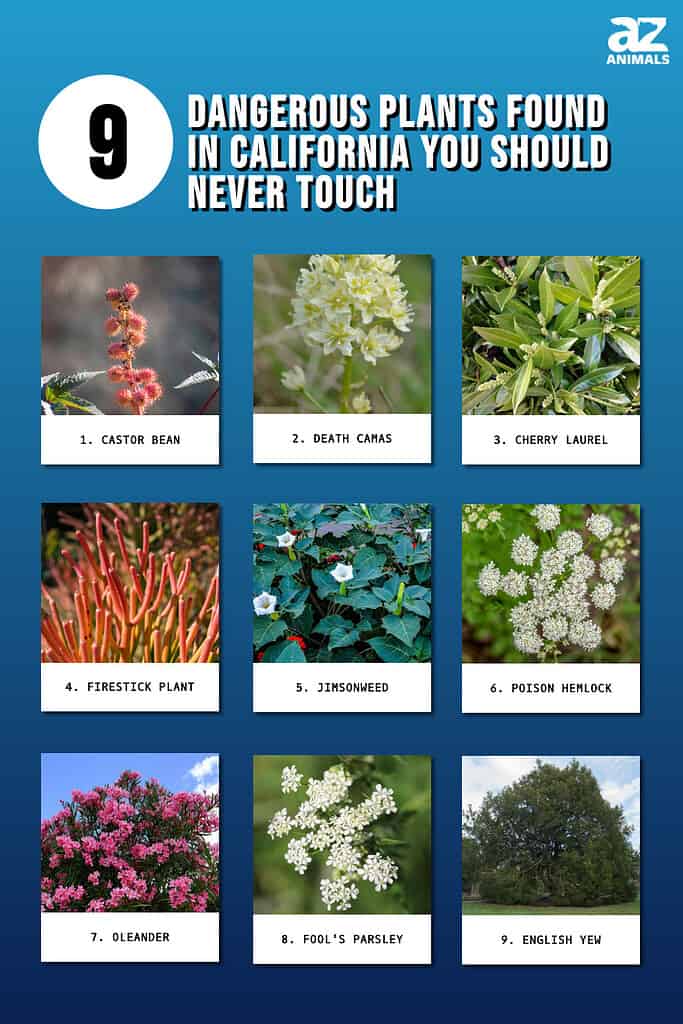
Onward to some dangerous California plants that are best left alone unless you know how to handle them without causing toxin exposure.
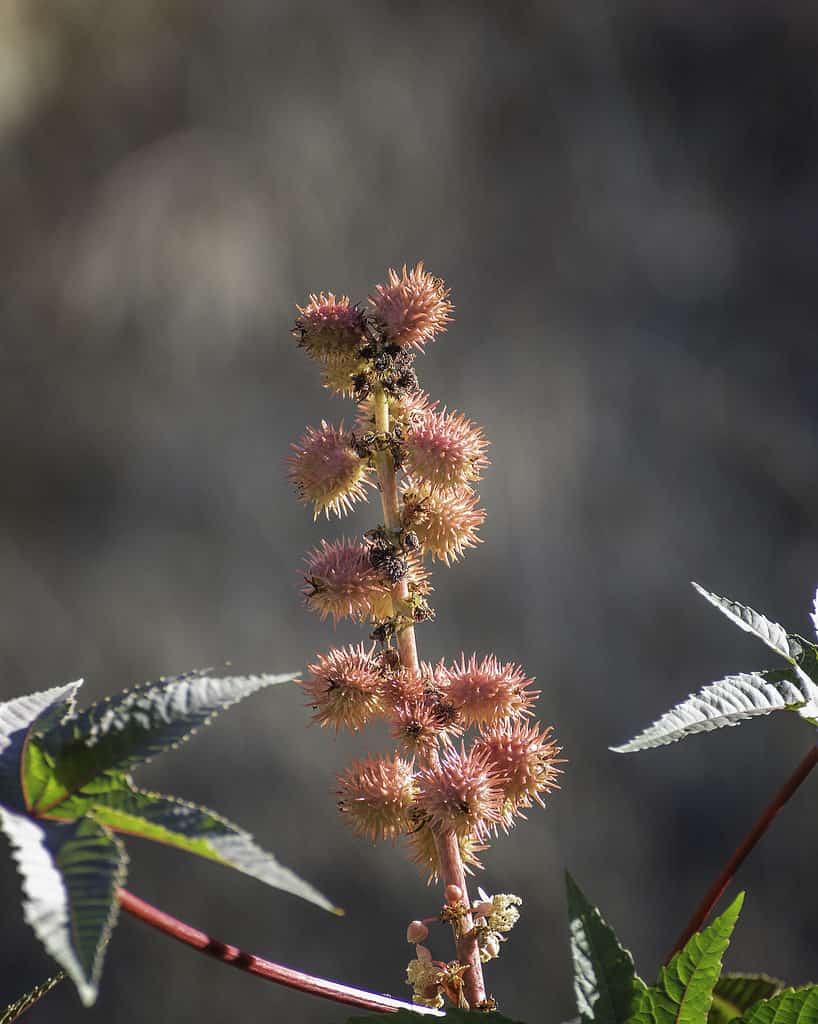
Castor bean plants are exotic-looking and extremely poisonous to humans and animals.
©iStock.com/GDMatt66
1. Castor Bean (Ricinus communis)
- Plant Description: Castor bean is an exotic-looking evergreen herbaceous shrub that could also look like a small tree at its mature height. It has large, glossy palmate leaves, woody stems, and showy cream and red flower clusters on tall stalks. Castor bean also produces golf ball-size pink, red, or green seed pods that turn spongy and brown.
- Mature Height: 30-40 feet
- Habitat: Disturbed areas with well-drained soils, fields, and near riverbeds
- Plant Toxins: According to the Centers for Disease Control and Prevention (CDC), castor bean seeds contain an extremely poisonous toxin called ricin. When this poison reaches cells, it prevents them from creating the proteins they need to survive.
- Toxic Parts of Plants: The hulls around castor bean seeds have the highest toxicity. However, highly poisonous ricin could transfer to all parts of the plant from damaged seed hulls or pods.
- Symptoms of Plant Poisoning: The CDC states that touching castor bean plants might cause minor skin redness and discomfort. However, transferring castor bean poison (ricin) from your hands to your mouth, nose, and eyes is possible. Or it could seep through cuts or scrapes on the skin. Once ricin has entered your body, the first symptoms could begin within a few hours. Severe symptoms might occur within 36-72 hours. These symptoms could include excessive salivation, diarrhea, bloody diarrhea, vomiting, severe dehydration, low blood pressure, muscle tremors, seizures, bloody urine, organ failure, and death. Inhalation of ricin fumes or smoke from burning plants could lead to respiratory distress within a few hours.
Take great care around castor bean plants because this ornamental shrub contains a deadly toxin called ricin. Though ricin is produced by the hulls around the seeds, damaged or animal-chewed seed pods could result in the poison transferring to other parts of the plant.
Deadly Noxious Weeds
The California Invasive Plant Council (Cal-IPC) states that caster bean plants have become noxious weeds in central and southern California. It has also become a deadly California invasive plant.
Cal-IPC warns that eating just 4-8 whole (hulls in-tact) seeds of the castor bean plant could kill a human adult. Unhulled seeds could also be highly toxic if exposed to ricin from damaged hulls, pods, or other already exposed plant parts.
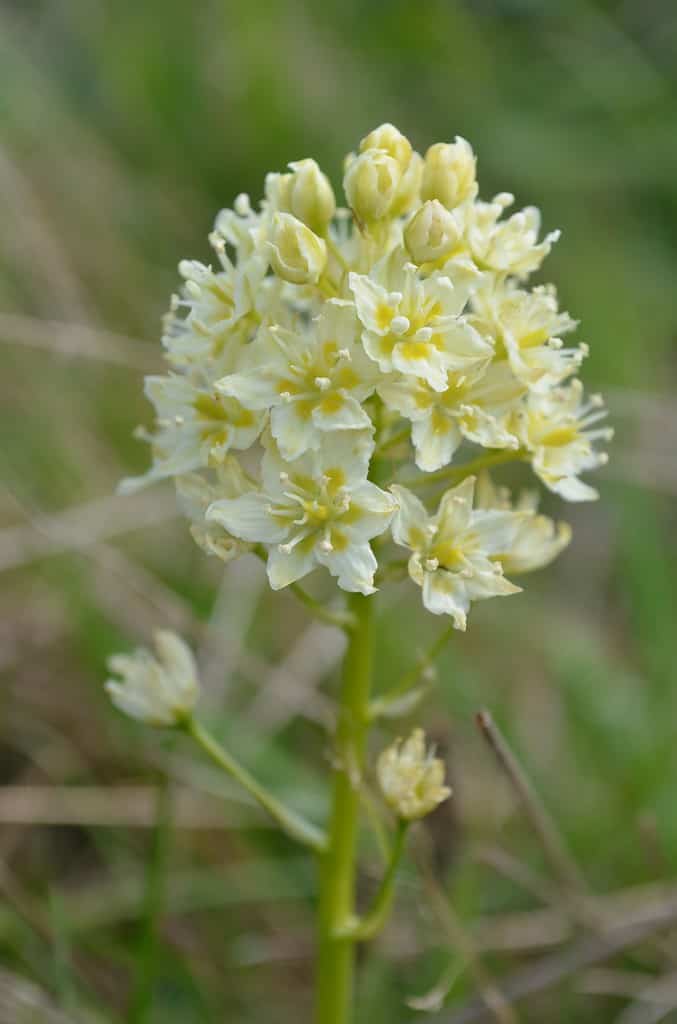
The death camas plant contains a highly toxic alkaloid called zygacine.
©Bureau of Land Management Oregon and Washington / CC BY 2.0 – License
2. Death Camas (Zigadenus spp.)
- Plant Description: Death camas plants produce tall, unbranching stalks topped with clusters of tiny white and green flowers with long yellow stamens. Its leaves are long, v-shaped, and grass-like.
- Mature Height: 25-30 inches tall
- Habitat: Grasslands, hillsides, forests, foothills, valleys, coastal and marsh areas
- Plant Toxins: A 2011 study published in the Journal of Animal Science determined that acute toxicity from death camas plants comes mainly from an alkaloid called zygacine.
- Toxic Parts of Plants: All parts of this plant are poisonous, including elements that are dried or dead
- Symptoms of Plant Poisoning: Ingesting any part of the death camas plant could result in excessive salivating, burning sensations in lips, mouth, and throat, numbness, abdominal pain, diarrhea, nausea, vomiting, slowed heartbeat, decreased blood pressure, difficulty breathing, coma, confusion, and death.
As a good rule of thumb, if the plant’s common name includes the word “death,” don’t touch it! Death camas (or deathcamas) plants are in the lily family and common in the Western United States. Multiple species of death camus plants are growing in California, like Zigadenus elegant.
Also called mountain deathcamas, this plant causes many accidental poisonings among grazing livestock. The U.S. Forest Service warns that mountain deathcamas poisoning in humans and animals can lead to death in severe cases.
Human poisoning from these plants happens most often because death camas flowers and bulbs resemble these same elements of onion plants.

Poisonous cherry laurel shrubs are dangerous plants found in California.
©LifeisticAC/Shutterstock.com
3. Cherry Laurel (Prunus laurocerasus)
- Plant Description: Cherry laurel is an evergreen shrub with dark green, oblong leaves. Its 5-inch long flower clusters are upright and full of tiny white blooms. These flowers later turn into black berries.
- Mature Height: 20-50 feet
- Habitat: Woodlands, and also grown as ornamental plants and hedges in yards and parks
- Plant Toxins: Cherry laurel contains toxic cyanide glycosides (prussic acid), which are life-threatening compounds if consumed in excess.
- Toxic Parts of Plants: All parts, especially the seeds, and leaves, are poisonous.
- Symptoms of Plant Poisoning: Eating any part of the cherry laurel plant could cause abdominal pain, nausea, vomiting, dizziness, headache, skin redness, slowed breathing, difficulty breathing, unconsciousness, palpitations, and death.
Though cherry laurel plants may have medicinal purposes, the risk of accidental poisoning for children and livestock is particularly concerning. Children and animals might snack on this plant’s poisonous berries.
Fortunately, cherry laurel leaves are bitter, so most animals don’t eat them. Or they spit them out immediately. However, the berries smell sweet and taste fine, besides a slightly bitter aftertaste.
This dangerous California plant has varying levels of toxicity based on the amount consumed, but eating any part of it could be deadly. So if you have this ornamental plant growing near your home, make sure your young children and animals don’t have access to it.

The red-orange tops of poisonous firestick plants look like sea coral, but they also contain toxic sap.
©Olga Kashubin/Shutterstock.com
4. Firestick Plant (Euphorbia tirucalli)
- Plant Description: The firestick plant is a succulent shrub with upright, branching stems that resemble the branching “fingers” of sea coral. Though green at the base, the tips of the finger-like branches turn a vibrant reddish-orange that’s hard to miss. During summer, the tops of firestick plants turn yellow and then glow reddish-orange again during winter.
- Mature Height: 4-8 feet
- Habitat: Grasslands, ridges, rocky outcrops, and areas with sandy soil
- Plant Toxins: A caustic, milky sap that causes burning of the skin and mucus membranes in the eyes, nose, and mouth. The sap contains latex with alkaloids believed to be the primary source of this plant’s toxins.
- Toxic Parts of Plants: All parts of the plant are toxic, live or dead.
- Symptoms of Plant Poisoning: Touching any part of the firestick plant can cause redness, swelling, and burning of the skin. Transfer of the sap to the eyes, nose, or mouth could cause burning in the mucus membranes. Ingesting any part of this plant could cause burning of the mouth, throat, and digestive tract.
The firestick plant has several common names, including pencil cactus, milk bush, and “sticks on fire.” The reference to fire is due to the fact that touching this dangerous plant found in California feels like getting burned. In truth, touching the firestick plant could cause very real mild to severe burns on the skin, depending on the level of exposure to its caustic, milky sap. In addition, transferring the sap from the skin to the eyes, nose, or mouth could result in pain and damage to mucus membranes. For example, eyes left untreated after exposure to firestick sap could lead to permanent blindness.
Firestick plants are brilliantly colored evergreen shrubs used as ornamentals in many California landscapes. But the dangers lurking inside this plant’s beautiful coral-like branches should not be taken lightly. For safety’s sake, the firestick plant should always be handled with protective gloves firmly in place.
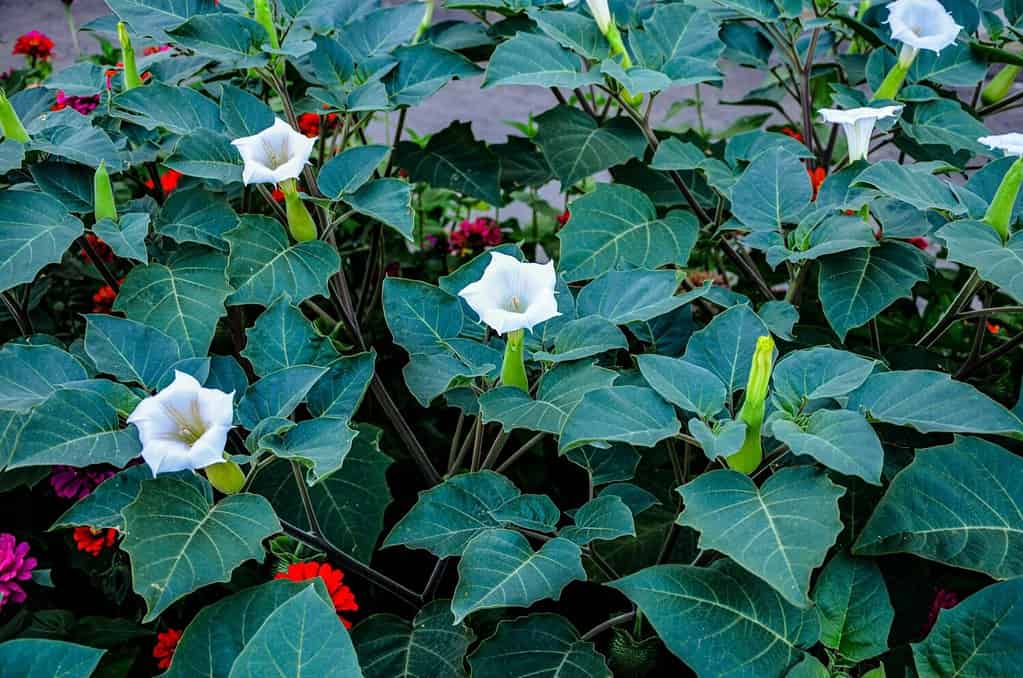
The jimsonweed plant has toxic tropane alkaloids that could cause seizures, coma, and death in humans.
©weha/Shutterstock.com
5. Jimsonweed (Datura stramonium)
- Plant Description: This species of jimsonweed is a bushy and branching herb with 3-8 inch toothed leaves, stout stems, and fibrous roots. It produces fragrant trumpet-shaped blooms in the summer that are mainly white with hints of lavender and violet. Jimsonweed also has 1-3 inch egg-shaped seed pods. Some seed pods are smooth, and others are covered with sharp spines.
- Mature Height: 2-5 feet
- Habitat: Disturbed areas and agricultural lands
- Plant Toxins: Datura plants contain highly toxic tropane alkaloids, including scopolamine, atropine, and hyoscyamine.
- Toxic Parts of Plants: All parts are poisonous, especially the seeds, roots, and leaves.
- Symptoms of Plant Poisoning: Touching jimsonweed could cause minor to severe skin irritations, especially in people with sensitive skin. Do not touch your eyes, nose, or mouth after touching jimsonweed to avoid poisoning through mucus membranes. Ingesting jimsonweed can cause diarrhea, nausea, vomiting, dizziness, confusion, convulsions, seizures, hallucinations, cardiac arrhythmia, urinary retention, coma, and death.
Jimsonweed is a psychoactive plant in the nightshade family known for its hallucinogenic qualities. But this dangerous plant found in California is also known for causing accidental poisonings resulting in seizures, coma, and death. Though jimsonweed produces beautiful flowers, growing this plant calls for extra precautions like keeping children and pets safe from accidental poisoning.
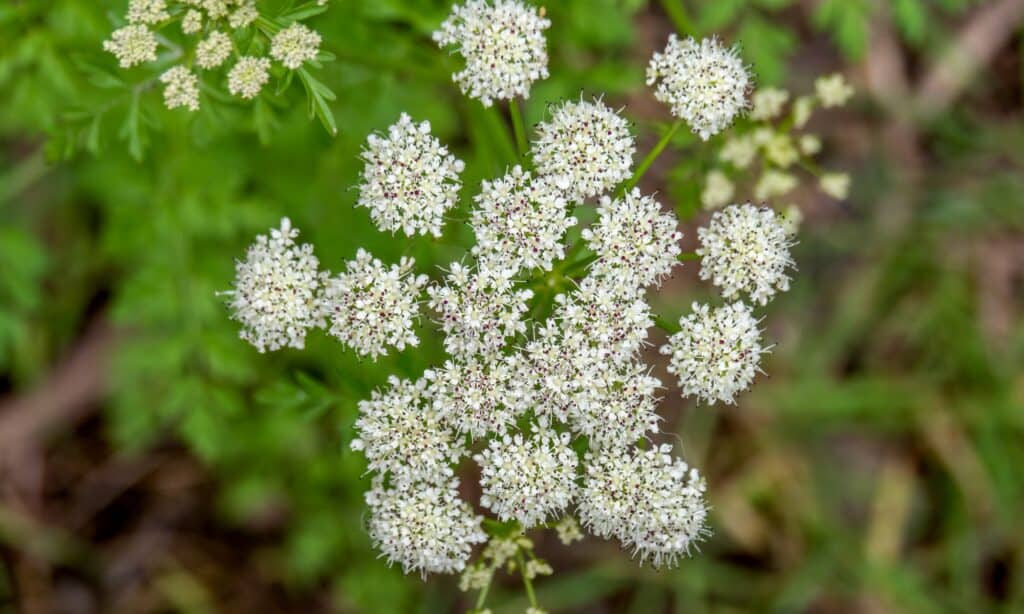
Highly toxic poison hemlock plants tend to grow in wet soil and near water sources, like streams.
©iStock.com/Goldfinch4ever
6. Poison Hemlock (Conium maculatum)
- Plant Description: The poison hemlock is an upright herbaceous plant with spotted stems, fern-like triangular leaves, and white flower clusters in loose umbrella shapes. The flowers mature into green seed pods that turn brown.
- Mature Height: 4-9 feet
- Habitat: Roadsides, wet soil fields, banks of streams, rivers, and marshes
- Plant Toxins: Poison hemlock contains coniine, g-coniceine, and other highly toxic alkaloids.
- Toxic Parts of Plants: All parts of this plant (live or dead) are poisonous.
- Symptoms of Plant Poisoning: Mild to severe cases of hemlock poisoning could result in nausea, dry mouth, vomiting, irregular heartbeat, sweating, weakness, low blood pressure, muscle paralysis, respiratory paralysis, organ failure, and death.
One of the most dangerous plants found in California is poison hemlock when ingested. Though touching this plant might not cause poisoning symptoms, its toxins could seep into skin wounds and scrapes. Or poison hemlock toxin could transfer to your eyes, nose, or mouth from your hands. For this reason, it’s important to wear gloves and protective clothing when handling this and other highly poisonous plants.
Poison hemlock is sometimes mistaken for edible plants like wild carrots and wild parsley. So it’s essential to learn to recognize this plant because eating it could be deadly.

Be careful around oleander shrubs because they contain lethal toxins.
©Happy window/Shutterstock.com
7. Oleander (Nerium oleander)
- Plant Description: This oleander species is a tall, evergreen shrub that grows quickly in warm climates. It has long lanceolate (wider at the bottom and tapers to a point) leaves and vibrant pink 5-petaled flowers. The flowers can grow up to 5 inches across.
- Mature Height: 6-20 feet
- Habitat: Sandy and stony soil around river and stream beds, plus as a landscape ornamental shrub
- Plant Toxins: Lethal toxins in oleander plants include oleandrin, which is a cardiac glycoside.
- Toxic Parts of Plants: All parts of oleander plants are toxic, including the leaves, flowers, twigs, and stems.
- Symptoms of Plant Poisoning: Touching oleander plants can cause minor skin irritation, like a red rash. Eating any part of the oleander plant could cause diarrhea, nausea, abdominal pain, vomiting, blurred vision, seeing halos around objects, weakness, an irregular heartbeat, low blood pressure, hives, confusion, dizziness, lethargy, fainting, depression, and death.
Californians love the oleander shrub for its vibrant flowers and lush foliage, but this is also a very dangerous plant. Ingesting any parts of oleander shrubs could lead to death. Though accidental poisoning of humans by oleander plants is rare, there have been some livestock poisoning cases. In particular, a farmer’s cows died from eating pruning residues containing oleander toxins. Pruning residues are the leftover waste materials from pruning trees.
There have also been cases of small children eating oleander leaves, but those occurrences are also rare. So just be aware of this plant’s high toxicity and keep oleander out of reach of children, livestock, and pets.

Like other members of the hemlock family, fool’s parsley plants contain highly poisonous alkaloids.
©Traveller70/Shutterstock.com
8. Fool’s Parsley (Aethusa cynapium)
- Plant Description: Fool’s parsley, or false parsley, is a flowering herb related to hemlock. It produces smooth triangular leaves, hollow branches, and small umbels (a flower cluster resembling an upside-down umbrella) with tiny white flowers. This plant is sometimes confused with edible parsley and Queen Anne’s lace.
- Mature Height: 12-24 inches
- Habitat: Open spaces like fields and meadows
- Plant Toxins: Poisonous compounds in fool’s parsley include a highly toxic alkaloid called coniine. This alkaloid is also the main toxin in poison hemlock plants.
- Toxic Parts of Plants: All parts of fool’s parsley plants are poisonous.
- Symptoms of Plant Poisoning: Ingesting fool’s parsley can cause burning of the throat and GI tract, stomach cramps, nausea, vomiting, diarrhea, convulsions, coma, respiratory failure, and death.
Fool’s parsley, or false parsley, is a relative of poison hemlock, so it’s no wonder this is a dangerous plant found in California that you should never touch! Like other plants in the hemlock family, fool’s parsley contains highly poisonous compounds.
Unfortunately, fool’s parsley has this common name because it is sometimes confused with edible parsley. However, fool’s parsley has a very unpleasant smell that usually keeps humans and animals that it might poison away. Still, accidental poisonings happen with this plant and can quickly become life-threatening.

The English yew is a poisonous conifer tree that grows in California.
©Peter Turner Photography/Shutterstock.com
9. English Yew (Taxus baccata)
- Plant Description: The English yew is an evergreen tree or large shrub with thin, scaly bark, needle-like leaves, and wide-spreading branches. As a conifer tree, it also produces seed cones that open with berry-like arils (fleshy seed coverings) that birds love to eat.
- Mature Height: 35-65 feet
- Habitat: Moist forests and small groves
- Plant Toxins: English yew contains a toxic alkaloid called taxine.
- Toxic Parts of Plants: All parts of the English yew can be poisonous, especially the seeds.
- Symptoms of Plant Poisoning: Eating any part of the English yew tree can cause blue lips, dizziness, headache, abdominal pain, diarrhea, nausea, vomiting, muscle weakness, convulsions, an irregular heartbeat, confusion, stupor, tremors, and possibly death.
Horses and cattle have died of accidental poisoning from eating the leaves of English yew trees. Unfortunately, this dangerous California plant doesn’t require large consumption of its leaves, seeds, and other parts to cause severe and life-threatening symptoms for humans and animals. Though the highest concentration of the toxin taxine is in this plant’s hard seeds, birds often dine on the fleshy outer seed casing called the aril. However, the dark pink aril also looks like a berry, so it might be just as enticing to small children. Be aware of the high toxicity of the seed it encases and the rest of the plant.
Dangerous Plants Found in California Require Awareness and Caution
While California is full of stunning plant life, it’s essential to be aware of the toxic species that can cause us harm. So familiarize yourself with these level-four “major” poisonous plants and be cautious when exploring nature. Wear protective clothing, carry a first aid kit, and don’t touch plants that aren’t familiar to you. After all, it’s better to appreciate unfamiliar plants from a safe distance than risk your health.
9 Dangerous Plants Found in California You Should Never Touch
| Rank | Dangerous Plant |
|---|---|
| 1 | Castor Bean |
| 2 | Death Camas |
| 3 | Cherry Laurel |
| 4 | Firestick Plant |
| 5 | Jimson Weed |
| 6 | Poison Hemlock |
| 7 | Oleander |
| 8 | Fool’s Parsley |
| 9 | English Yew |
The photo featured at the top of this post is © iStock.com/Jack Tankard
Thank you for reading! Have some feedback for us? Contact the AZ Animals editorial team.







